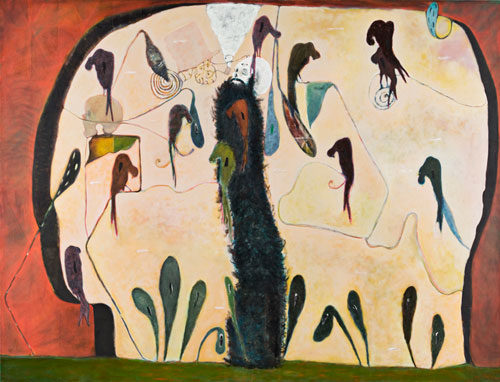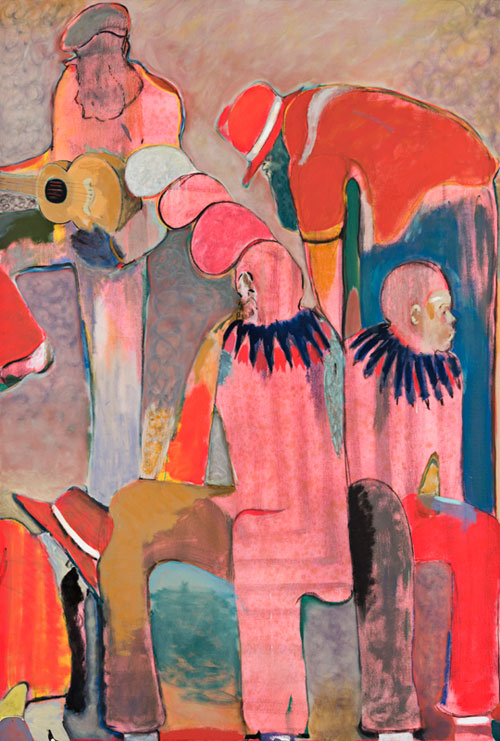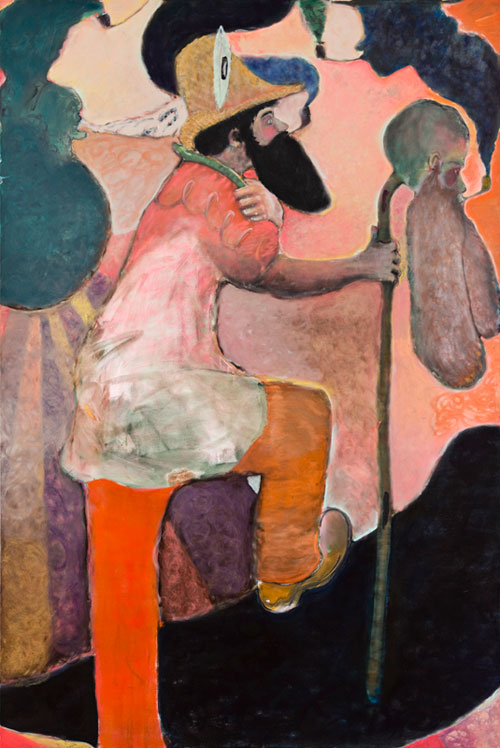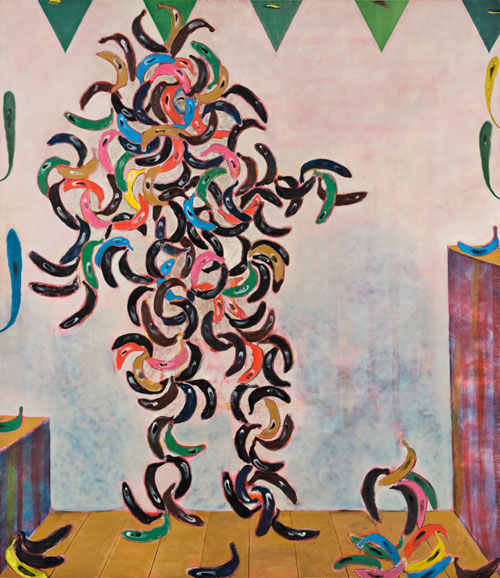

Alison Jacques Gallery, London
21 February – 15 March 2014
by HARRIET THORPE
While building on the distinctive world he has created in previous works, Mosley also presents a subtle evolution of motif and form. This occurs in a cyclical motion of regeneration, where ideas are recycled and reproduced through Mosley’s thought process. A recent trip to America has made an impression on the creation of these works. He began his journey in New York City after the opening of a show, flew down to San Francisco, and then drove back, visiting provincial museums and major collections of contemporary and historical art along the way. More poignant to Mosley, however, are the indirect references that have surfaced on returning to his studio, after his mind has had time to process this experience.
I meet Mosley the day after opening night, when I had entered the busy Alison Jacques Gallery to find him surrounded, the centre of attention. “That’s the confusing thing with private views, you have all these half conversations, you hear so many different voices and people saying different things. I was intrigued that people were interested in the technicalities of paint application. I’ve never really had that at a private view,” he says. So it seems that London, like me, was thirsty for an exhibition of contemporary painting, as well as a cold, bottled beer on a Thursday night. Consequently, practice and process was where our conversation began.
Mosley works in Sheffield and London, but most of the works in this exhibition were created in his Sheffield studio. We discuss the significance of the studio space, comparing differences between the two locations. “As soon as you shut that studio door, you could be anywhere,” Mosley concludes. “And that was my thinking behind moving to Sheffield, just being able to get your head down and not be disturbed.”
He tells me his practice has gradually become disconnected from the process of drawing, as a tool to escape the prescribed outcome of a painting. “I used to know what the painting would look like, because I would have this blueprint or these working diagrams. I found that it impaired the way I was painting; the drawings were way more spontaneous, and the painting became a pastiche of the drawing. It was a no brainer: I got rid of the drawing process and, in turn, knowing what I would paint.” He describes how the paintbrush became more like a pencil, but with some limitations: “I think you can end up chasing your tail, or paint yourself into a corner, but at the same time you can be led somewhere that you couldn’t predetermine. It’s like taking on and embracing the fluke; that spontaneity and not knowing what could happen. But then, saying that, recently I’ve realised that there is a happy medium. I do these little sketchbooks, almost like diagrams and annotated notes rather than actual drawings – more just reminders of thoughts which I think could be interesting, or ideas to chase a little bit, so that’s the closest I get to drawings now.”
Recurring motifs in his work include the vanitas, the harlequin-diamond print, portraits in profile and severed limbs among a whole cast of curious characters. In this exhibition, Mosley recognises that some of these motifs have now become more obvious stand-ins for figurative forms. “A few years ago, I came to the same conclusion with painting the cactus. I’m not sure why, in Britain in 2008 this came about, but it was like an understudy, which was anthropomorphic, so it was botanical and also human-like. I thought, could I get away with this? Is there enough information here without being too explicit that it is a figure? Was it relevant to paint a figurative picture, was it outmoded or outdated? You always give yourself these slightly tenuous challenges maybe.”
Mosley takes advantage of the works around us and gives me an example: “So here, this skull, which is growing a beard, which is supporting it – is that the right amount of information for it to be read as a stand-in for something figurative?” We are standing before Audubon’s Last Aviary (2014), which is one of the larger pieces in the main room. A skull with a long solid column of beard is central to a horde of clustered and perched birds. Mosley says the birds are a new introduction to his family and they follow in a similar pictorial notion to the cactus motif. “I think the birds are made of that same thing, they’re an evolution that initially came from this idea of being able to reference something figurative, without being overly articulate with it.” The birds are grouped in couplets, resembling tadpoles, undefined foetuses or perhaps an underdeveloped species.
The painting is titled after John James Audubon (1785-1851), an ornithologist who emigrated from France to America in 1803. Audubon studied and catalogued species of birds scientifically, but his studies were also beautiful and detailed works of art. “I remember watching a programme about Audubon,” says Mosley. “He had quite an interesting life and his life’s work was to trace these birds and their flight patterns. Imagine seeing 25 species of bird you had never seen before, ranging from canaries to eagles to flamingos. It must have been such a fantastical time; that was at the end of this slightly primitive, savage existence where you were still allowed to kill someone in defence. It was like the end of an era and the start of modernity, the old world and the new world colliding.” As we travel through Mosley’s words to Audubon’s world, I feel we are also entering the world of Mosley’s paintings. “He was out there while people were trapping bison and killing species of animals and birds. Again that comes back to this depiction of the wild west. I felt that was an anchor enough to justify painting this,” explains Mosley.
The birds are forlorn-looking and there is a certain darkness to the painting. Mosley continues: “Audubon genuinely loved his work, but to document, he had to trap and kill these birds, so there’s something very dark and brutal here. Taxidermy was often held together with wires, and that’s why they’re slightly decrepit. There’s an awkwardness to them. The birds look malnourished and hard done by like a sub-species that he never got around to annotating. And ultimately, this vanitas, this skull with the beard is Audubon, with his final aviary.”
This underlying darkness of the subject matter is heightened by an infiltrating darkness of colour among earthy and vibrant shades. “It’s like someone has turned the dial up on the contrast,” Mosley explains, and a factor contributing to this was the process of making paint from scratch. “In the United States, I couldn’t get hold of some of the oil paints I was used to, and I thought, can I make a painting? You build these rules and regulations when you make the painting. It’s a habitual thing; you need to be painting this amount of days and hours a week, and use this oil paint … I thought, when did I set these rules? I still used tubed oil paint, but then literally buying raw paint and drying it with poppy seed and linseed oil actually makes such a difference to the range of colours.”
We move towards Smoking Pilgrimage (2014), looking at the contrasts in colour, where a bearded man in cloudy orange-and-white overalls is smoking a pipe, and a dark curved diagonal of black paint travels like an oil slick through the scene. Mosley continues talking: “With the orange, which sits next to that pink, they’re all pigments. I found I was painting in layers that were much thinner, they were almost like watercolours. Again, that is to do with making paints that are gloopy, luscious and seductive, much thinner and more visceral.”
“I suppose there is a duality there, a complete contrast. I noticed a lot of the figures seem to have darker hair, it just became a habitual thing to denote a beard or an afro – or was it just a painterly device which broke up those vivid colours. When you’ve gone so far down the road, you’ve invested so much time in a painting and it’s not happening, you throw a curve ball in there.” He gestures towards the solid stream of darkness in the foreground of the work: “So, this black mass here is made from the same substance emitted from the pipes that these guys are smoking. It’s like a silhouetted hologram, which is a framing device. Initially, it was a kind of hill or a slide, but it felt like it was being too overly articulate, whereas it was actually more interesting to get lost in the process of it being ambiguous. Sometimes it feels like a painting is just going to fall away and you just need to anchor it.”
So where is this fantastical land we are in? The answer is that we are in Mosley’s imagination. He puts out a disclaimer: “This is going to make me seem lazy, but if you go and paint firsthand, would it then just be a souvenir? In painting something that you’ve never experienced, there’s something fantastical about it. Living in a forest and painting forest scenes would be an amazing thing, but would it be too much about the notion of being there, whereas there’s something more abstract about it if you’re not witnessing it firsthand; there’s more guessing and more freedom. It can be important to get away from the subject. We take in so much, we digest and then we emit it. I wouldn’t go to Texas and just paint cacti. I’m not sure I would want to do that. Whereas painting things that could be suggestive offers up a bit more scope for intervention.”
In Between Seamers (2014), a casual group of figures in bright coloured uniforms, wearing various hats, collect together informally. One carries a ukulele and two lean against each other in comfortable companionship. I am beginning to understand Mosley’s interest in blurring the lines between the figurative and the anthropomorphic, and even the abstract. I ask him why use the figure in this composition, why not the cactus? He challenges me: “I think the cactus motif does appear in various guises, even with a tentative link, you see this armpit here [he points to the armpit of one particular character], it appears and I think, ‘Am I just kidding myself or is this just a sheer coincidence?’ It’s like pairing down that anatomical structure in the attempt to paint something representational.” Clear now that these forms are not meant to be categorised, Mosley politely returns to my question about the figurative nature of the painting. “When you’re creating a cast of characters and a narrative, I like to think that they’re evolving and dissolving at the same time. They either go left or right, becoming more representational, or they just fall away. It goes back to how much information is needed and if it’s an attempt at storytelling, can you be smarter with the narrative.”
I ask Mosley about the narrative behind The Seamers. “As the painting evolved, I started to think about the characters being at work. If they were working, what would they be doing and where would they go at the end of the night. You end up thinking about things that really aren’t that important. They’re working guys, kicking back, there’s a sense of revelry there, but they’re slightly broken. But that wasn’t initially the thinking behind it. I allowed motif, gesture and pattern to dictate something figurative. A few weeks into the painting, they start to suggest these narratives and you either run with it or it doesn’t work and you get rid of it. I end up getting rid of more paintings than I keep. It’s a good way of letting natural selection happen.”
The fluorescent pink plays a returning role on the diamond-patterned tunics and the bright uniforms provoke the viewer into thinking twice about the reality of this scene. “There’s this theatrical performative element, like the spaghetti westerns. Growing up watching these films about cowboys and indians, they were never really filmed in the west. I guess it’s this Hollywood effect. They are these provincial actors playing the part of the harlequin or the miner – or someone playing the ukulele in his lunch hour. If I sat down and wrote a narrative about who these people were, would it become too limited? At the moment there’s this feeling that you’re not sure.”
The Educationalist (2014) is the final work we stand before, where a figure – I use the term broadly – constructed of floating bananas is the star of the show. Mosley takes me on a visual tour of the painting and we start with the basic unit of the cactus. “Initially, this evolved from that simplified cactus motif, that evolution from the figure becoming the cactus in previous paintings. From that, it evolved into this botanical shape; a fruit, a banana, whatever it may be. It was an attempt to present the figure, which had gone full cycle; a figure to a cactus to this evolutionary motif, and back to a figure again. And again, how much descriptive painting do you need for it to be seen as a figure? When do you say stop? When is one banana a banana too many?”
Mosley’s Educationalist has a small face that peers out from among the bananas. It is owl-like in form, with featherlike brushstrokes and small gleaming eyes. “After two to three weeks of painting, I painted the face. I felt it needed something that made it gravitate towards it being a wise figure if it was going to be this person who was a tutor, a mentor, a teacher or a performer. I wanted it to feel like a wise owl; the blue banana became a beak and the painted marks appeared almost like a camouflage of pattern. So through default it became an ‘educationalist’. It could have been a clown or a minstrel, but he became more purposeful in his wisdom.” The Educationalist is surrounded by framing devices, a bunting stretches across the top, floorboards at the base, and stage-blocks left and right. Mosley says: “I always felt it could be a re-enactment of Shakespeare, going back to that provincial stage, but he wasn’t on Broadway, it certainly wasn’t the West End, this was something much more low-fi.”
Reminded of Jaques’ speech from Shakespeare’s As You Like It: “All the world’s a stage, And all the men and women merely players”, I start to wonder, far too philosophically, where the division between imagination and reality really is. Mosley draws back the curtains, allowing us further and deeper into his world, which by the end of our conversation, reveals itself to be theoretically multidimensional as well as imaginative.



